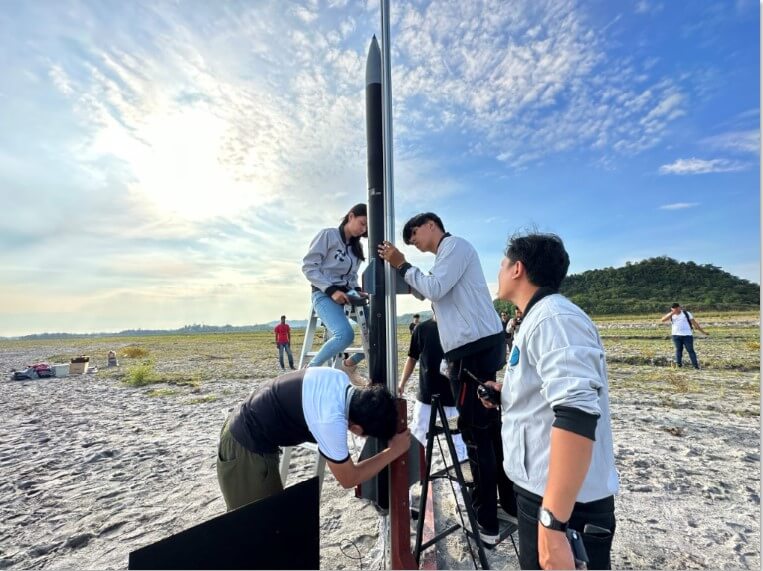
After months of anticipation, all eyes are set on the TALA Hybrid Rocket—the first high-power hybrid rocket developed in the Philippines—as it readies for its inaugural launch.
This major milestone for Philippine space technology is the fruit of years of labor by a remarkable group of homegrown space technology researchers, students, and their mentors from St. Cecilia’s College-Cebu.
A Rescheduled Launch: The Price of Perfect Conditions
The highly anticipated TALA rocket was originally scheduled for launch on May 19. However, it had to be rescheduled for May 20 due to unfavorable environmental conditions in the early morning hours of the first planned launch. With the launch window spanning from May 19 to 21, the TALA team still has ample opportunity to ensure a successful flight from Crow Valley in Capas, Tarlac.
The successful launch of a rocket depends on several weather factors, including temperature, wind velocity, humidity, and precipitation. Each of these elements impacts not only the launch but also the rocket’s overall performance, underlining the importance of a clear, calm launch day.
The first high-power hybrid rocket developed in the Philippines by homegrown space technology researchers, students, and their mentors from St. Cecilia’s College-Cebu will attempt launch on Saturday, May 20, 2023 @PhilSpaceAgency https://t.co/D4sAYeYwqA
— GoodNewsPilipinas.com (@GoodNewsPinas_) May 20, 2023
A Journey Through Time: From Initial Plans to the Rescheduled Launch
This isn’t the first rescheduling for the TALA team. Originally planned for launch in March 2020 from Mati City Airport, Davao Oriental, the launch had to be postponed indefinitely due to the global pandemic.
Since early 2022, however, the TALA team has been working closely with the Philippine Space Agency (PhilSA) and the Philippine Air Force Research and Development Center to reignite the launch’s momentum.
The Cutting-Edge TALA Hybrid Rocket: Built with 3D-Printed Composite Materials
Measuring 10 feet in height and weighing 15 kilograms, the TALA hybrid rocket, created in 2018, is an impressive feat of engineering. It was designed using 3D-printed advanced composite materials under the Young Innovators Program of the DOST-PCIEERD.
The Exciting Features: Flight Sensors, GPS, and a CanSat Deployment System
Notable features of the TALA rocket include flight sensors, a GPS, a dual parachute deployment, and a payload system designed to carry a Can Satellite (CanSat) up to approximately 5 kilometers into the atmosphere.
According to the TALA team, using hybrid rockets to send CanSats into the atmosphere is a more effective method than deploying these simulated satellites with drones. With the ability to reach higher altitudes, hybrid rockets offer promising possibilities for educational settings, allowing students to remotely gather environmental data.
As the TALA Hybrid Rocket’s rescheduled launch nears, we join the rest of the world in watching the Philippines’ first high-power hybrid rocket ascend into the skies. If all goes well, the TALA Hybrid Rocket will not only bring a CanSat into the atmosphere but will also carry the pride and dreams of its homegrown developers and the entire nation into the annals of space exploration history.
The Philippines has been innovating in space technology and developed the country’s first microsatellites, Diwata microsats which completed space missions, and the Maya cube satellites which were successfully launched into space.
SEND MABUHAY CHEERS in the comments below to the teams behind the development of the first high-power hybrid rocket developed in the Philippines set for launch today!
Good News Pilipinas is a Lasallian Scholarum Awardee. TELL US your good news story tips by messaging GoodNewsPilipinas.com on Facebook, Twitter, Instagram, or e-mail editor@goodnewspilipinas.com and WATCH Good News Pilipinas TV YouTube & Good News Pilipinas TikTok for more Filipino Pride stories!
The post Will Today’s Launch Make History? Inside the TALA Hybrid Rocket, the Philippines’ First High-Power Rocket appeared first on Good News Pilipinas.
Source: Good News Pilipinas
0 Comments